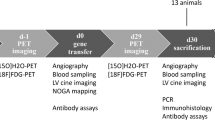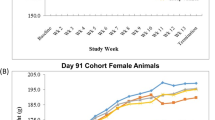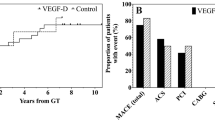Abstract
Adenovirus-mediated VEGF gene delivery is being evaluated in clinical trials as a treatment for patients with vascular diseases that stem from ischemia, such as diffuse coronary artery disease and peripheral vascular disease. Although adenoviral vectors are one of the most widely utilized vectors to deliver therapeutic genes to cells, they also have a major limitation in that their inherent immunogenicity leads to the production of neutralizing antibodies that block effective repeat administration. Although this may be true of intravenous, intranasal, and other routes of administration, recent studies have indicated that it may be possible to effectively readminister adenovirus to skeletal muscle. The present study found improved efficacy after administration of AdVEGF121.10, an E1/E3-deleted adenovirus encoding human VEGF121 under the control of a CMV promoter in a rat hindlimb ischemia model. As expected, repeat administration of adenovirus resulted in a marked increase of circulating neutralizing antibody, yet nanogram quantities of VEGF protein were still detectable within the hindlimb skeletal muscle after a second administration of vector. The amount of VEGF protein produced after repeat administration translated into improved efficacy as evidenced by increased blood flow as measured by laser Doppler, increased vessel number upon post-mortem angiography, and an increased number of CD31-positive vessels. These findings have important implications for increasing the efficacy of adenovirus-mediated gene therapy in the treatment of peripheral vascular disease and coronary artery disease.
This is a preview of subscription content, access via your institution
Access options
Subscribe to this journal
Receive 12 print issues and online access
$259.00 per year
only $21.58 per issue
Buy this article
- Purchase on Springer Link
- Instant access to full article PDF
Prices may be subject to local taxes which are calculated during checkout








Similar content being viewed by others
References
Wilson JM . Adenoviruses as gene-delivery vehicles. N Engl J Med 1996; 334: 1185–1187.
Trapnell BC, Gorziglia M . Gene therapy using adenoviral vectors. Curr Opin Biotechnol 1994; 5: 617–625.
Thiele GM, Okano M, Purtilo DT . Enzyme-linked immunosorbent assay (ELISA) for detecting antibodies in sera of patients with adenovirus infection. J Virol Methods 1989; 23: 321–332.
Bromberg JS, DeBruyne LA, Qinn L . Interactions between the immune system and gene therapy vectors. Bidirectional regulation of response and expression. Adv Immunol 1998; 69: 353–409.
Yang Y, Li Q, Ertl HC, Wilson JM . Cellular and humoral immune responses to viral antigens create barriers to lung-directed gene therapy with recombinant adenoviruses. J Virol 1995; 69: 2004–2015.
Yang Y et al. Immune responses to viral antigens versus transgene product in the elimination of recombinant adenovirus-infected hepatocytes in vivo. Gene Therapy 1996; 3: 137–144.
Barr D et al. Strain related variations in adenovirally mediated transgene expression from mouse hepatocytes in vivo: comparison between immunocompetent and immunodeficient inbred strains. Gene Therapy 1995; 2: 151–155.
Yang Y, Greenough K, Wilson JM . Transient immune blockade prevents formation of neutralizing antibody to recombinant adenovirus and allows repeated gene transfer to mouse liver. Gene Therapy 1996; 3: 412–420.
McClane SJ, Chirmule N, Burke CV, Raper SE . Characterization of the immune response after local delivery of recombinant adenovirus in murine pancreas and successful strategies for readministration. Hum Gene Ther 1997; 8: 2207–2216.
Mastrangeli A et al. ‘Sero-switch’ adenovirus-mediated in vivo gene transfer: circumvention of anti-adenovirus humoral immune defenses against repeat adenovirus vector administration by changing the adenovirus serotype. Hum Gene Ther 1996; 7: 79–87.
Mack CA et al. Circumvention of anti-adenovirus neutralizing immunity by administration of an adenoviral vector of an alternate serotype. Hum Gene Ther 1997; 8: 99–109.
Kass-Eisler A et al. Circumventing the immune response to adenovirus-mediated gene therapy. Gene Ther 1996; 3: 154–162.
Ilan Y et al. Insertion of the adenoviral E3 region into a recombinant viral vector prevents antiviral humoral and cellular immune responses and permits long-term gene expression. Proc Natl Acad Sci USA 1997; 94: 2587–2592.
Chirmule N et al. Role of E4 in eliciting CD4 T-cell and B-cell responses to adenovirus vectors delivered to murine and non-human primate lungs. J Virol 1998; 7: 6138–6145.
Wang Q et al. Persistent transgene expression in mouse liver following in vivo gene transfer with a ΔE1/ΔE4 adenovirus vector. Gene Therapy 1997; 4: 393–400.
Qian HS et al. Improved adenoviral vector for vascular gene therapy. Beneficial effects on vascular function and inflammation. Circul Res 2001; 88: 911–917.
Lochmuller H et al. Immunosuppression by FK506 markedly prolongs expression of adenovirus-delivered transgene in skeletal muscles of adult dystrophic [mdx] mice. Biochem Biophys Res Commun 1995; 213: 569–574.
Kuriyama S et al. Transient cyclophosphamide treatment before intraportal readministration of an adenoviral vector can induce re-expression of the original gene construct in rat liver. Gene Therapy 1996; 6: 749–757.
Lei D et al. Nondepleting anti-CD4 antibody treatment prolongs lung-directed E1-deleted adenovirus-mediated gene expression in rats. Hum Gene Ther 1996; 7: 2273–2279.
Kolls JK et al. Use of transient CD4 lymphocyte depletion to prolong transgene expression of E1-deleted adenoviral vectors. Hum Gene Ther 1996; 7: 489–497.
Yang Y et al. Transient subversion of CD40 ligand function diminishes immune responses to adenovirus vectors in mouse liver and lung tissues. J Virol 1996; 70: 6370–6377.
Kay MA et al. Long-term hepatic adenovirus-mediated gene expression in mice following CTLA4Ig administration. Nat Genet 1995; 11: 191–197.
Rosengart TK et al. Angiogenesis gene therapy: Phase I assessment of direct intramyocardial administration of an adenovirus vector expressing VEGF121 cDNA to individuals with clinically significant coronary artery disease. Circulation 1999; 100: 468–474.
Rajagopalan S et al. Adenovirus-mediated gene transfer of VEGF121 improves lower-extremity endothelial function and flow reserve. Circulation 2001; 104: 753–755.
Losordo DW et al. Gene therapy for myocardial angiogenesis: initial clinical results with adirect injection of phVEGF165 as a sole therapy for myocardial ischemia. Circulation 1998; 98: 2800–2804.
Symes JF et al. Gene therapy with vascular endothelial growth factor for inoperable coronary artery disease. Ann Thorac Surg 1999; 68: 830–837.
Vale PR et al. Left ventricular electromechanical mapping to assess efficacy of phVEGF165 via a minithoracotomy. Circulation 2000; 102: 965–974.
Isner JM et al. Clinical evidence of angiogenesis after arterial gene transfer of phVEGF165 in-patient with ischaemic limb. Lancet 1996; 348: 370–374.
Baumgartner I et al. Constitutive expression of phVEGF165 after intramuscular gene transfer promotes collateral vessel development in patients with critical limb ischemia. Circulation 1998; 97: 1114–1123.
Isner JM et al. Treatment of thromboangitis obliterans (Buerger's disease) by intramuscular gene transfer of vascular endothelial growth factor: preliminary clinical results. J Vasc Surg 1998; 28: 964–973.
Ferrara N, Davis-Smyth T . The biology of vascular endothelial growth factor. Endocr Rev 1997; 18: 4–25.
Zachary I, Gliki G . Signaling transduction mechanisms mediating biological actions of the vascular endothelial growth factor family. Cardiovasc Res 2001; 49: 568–581.
Poltorak Z et al. VEGF145, a secreted vascular endothelial growth factor isoform that binds to extracellular matrix. J Biol Chem 1997; 272: 7151–7158.
de Vries C et al. The fms-like tyrosine kinase, a receptor for vascular endothelial growth factor. Science 1992; 255: 989–991.
Millauer B et al. High affinity VEGF binding and development expression suggest Flk-1 as a major regulator of vasculogenesis and angiogenesis. Cell 1993; 72: 835–846.
Terman BI et al. Identification of the KDR tyrosine kinase as a receptor for vascular endothelial growth factor. Biochem Biophys Res Commun 1992; 187: 1579–1586.
Battegay EJ . Angiogenesis: mechanistic insights, neovascular diseases, and therapeutic prospects. J Mol Med 1995; 73: 333–346.
Carmeliet P . Mechanisms of angiogenesis and arteriogenesis. Nat Med 2000; 6: 389–395.
Tsurumi Y et al. Direct intramuscular gene transfer of naked DNA encoding vascular endothelial growth factor augments collateral development and tissue perfusion. Circulation 1996; 94: 3281–3290.
Mack CA et al. Biologic bypass with the use of adenovirus-mediated gene transfer of the complementary deoxyribonucleic acid for vascular endothelial growth factor 121 improves myocardial perfusion and function in the ischemic porcine heart. J Thorac Cardiovasc Surg 1998; 115: 168–176.
Rivard A et al. Rescue of diabetes-related impairment of angiogenesis by intramuscular gene therapy with adeno-VEGF. Am J Pathol 1999; 154: 355–363.
Gowdak LHW et al. Adenovirus-mediated VEGF121 gene transfer stimulates angiogenesis in normoperfused skeletal muscle and preserves tissue perfusion after induction of ischemia. Circulation 2000; 102: 565–571.
Chen P, Kovesdi I, Bruder JT . Effective repeat administration with adenovirus vectors to the muscle. Gene Therapy 2000; 7: 587–595.
Massari I et al. Age-dependent effects of repeated immunization with a first generation adenovirus vector on the immune response and transgene expression in young and old rats. Exp Gerontol 2002; 37: 823–831.
Lee RJ et al. VEGF gene delivery to myocardium: deleterious effects of unregulated expression. Circulation 2000; 102: 898–901.
Wilt TJ . Current strategies in the diagnosis and management of lower extremity peripheral vascular disease. J Gen Intern Med 1992; 7: 87–101.
The Centers for Disease Control and Prevention. Trends in ischemic heart disease deaths – United States, 1990–1994. JAMA 1997; 277: 1109.
Author information
Authors and Affiliations
Rights and permissions
About this article
Cite this article
Perrin, L., June, J., Rosebury, W. et al. Increased revascularization efficacy after administration of an adenovirus encoding VEGF121. Gene Ther 11, 512–521 (2004). https://doi.org/10.1038/sj.gt.3302173
Received:
Revised:
Accepted:
Published:
Issue Date:
DOI: https://doi.org/10.1038/sj.gt.3302173



